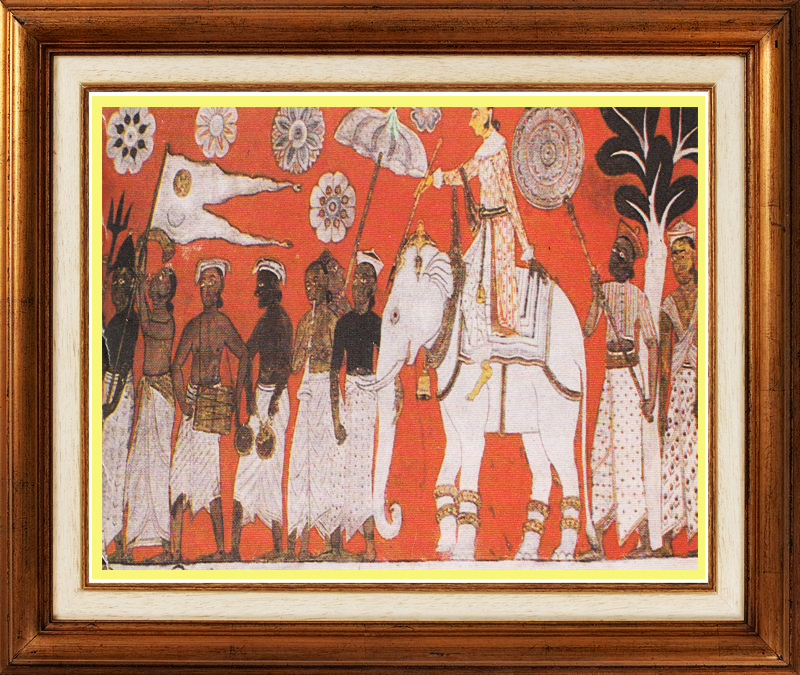මහනුවර යුගයේ විහාරය ප්රතිසංස්කරණය කිරීමේදී පැරණි සිතුවම් කර ඇත. ඔවුන් පැරණි පියාපත් දෙකේ කුටි දෙකක බිත්ති සහ සිවිලිම් අලංකාර කළහ. මෙම පැරණි සිතුවම්වල සිංහල චිත්ර කලාවට දකුණු ඉන්දීය බලපෑම පැහැදිලිව දැකගත හැකි විය. සමාජ ජීවිතය සහ ඇඳුම් පැළඳුම් සම්බන්ධයෙන් බටහිර බලපෑමේ සලකුණු ද තිබේ.
විහාරගෙය නොහොත් ප්රතිමා ගෘහය දැන් වහලවල් දෙකක් යට එක ගොඩනැඟිල්ලක පැරණි හා නව දේවාල කාමර දෙකකින් සමන්විත වේ. ඈතින් පෙනෙන මාලිගාවේ පෙනුම ඉතා ආකර්ෂණීයයි. ළං වන විට එය ගොඩනැගූ අයගේ විස්මිත කලාත්මක හැකියාව අපගේ සිත් ගත්තේය.

විහාරගෙය දිග අඩි 150 ක් සහ පළල අඩි 90 කි. එය අඩි 3 ක් උස ගල් කුළුණක් මත පිහිටා ඇත. නව දේවාල කාමරයට උඩින් උඩරට සෙවිලි ක්රමයට සෙවිලි කරන ලද අෂ්ටාස්ර වහලකි.
පිටත බිත්ති වටා එක් කෙළවරක සිට අනෙක් කෙළවර දක්වා දකුණට දිවෙන විසිතුරු කැටි තුනක් ඇත. පළමු කැටි කිරීම, පතුලේ ඇත්ගොව්වන් සහ කැටයම් උගුල් සහිත අලි පේළියකි. දෙවන කැටි කිරීම ඔවුන්ගේ විගඩම් ප්රදර්ශනය කරමින් ප්රීතිමත් කුඩා වාමන පේළියකි. තුන්වන කැටි කිරීම යනු පූජනීය පාත්තයින් ලෙස ජනප්රිය වූ පාත්තයින් පේළියකි.
මෙම කැටි ගැසීම්වලට ඉහළින් සහ පිටත බිත්තිවල එක් එක් පැත්තෙහි විමාන හෝ දෙවියන්ගේ මන්දිර ලෙස හැඳින්වේ. මෙම අවපාත හෝ ඇල්කොව් නවයක් ඇත. මෙම විමාන කැලණියේ නව අංගයකි. ශ්රී ලංකාවේ අපට ඔවුන් හමුවන අනෙක් එකම ස්ථානය පොළොන්නරුවයි.
වමට හැරී, ඔබ දක්ෂිණාවර්තව ගමන් කරන විට, ඔබට මුලින්ම හමුවන්නේ ප්රඥාවේ හින්දු දෙවියා වන ගනේෂා සහ ඉගෙනීමේ අනුග්රාහක දෙවියා ය. විශාල බඩක් සහ ඇතෙකුගේ හිසක් සහිත වාඩි වී සිටින ඉරියව්වෙන් ඔහු අර්ධ-මිනිසෙක් සහ අර්ධ අලියෙකු විසින් නියෝජනය කරනු ලැබේ.
මීළඟ විමාන වන්නේ කඳුකරයේ රජු වන හිමවත්ගේ දියණිය වන ගංගා දේවිය නොහොත් ගංගා දේවතාවියගේ ය. “දිගු වූ ඇස්, බල්බ සහිත පියයුරු, විලෝ ඉණ සහ ලිසම් අත් පා” සහිත ඇගේ රුව ඇය දෙස නෙත් යොමු කරන ඕනෑම කෙනෙකුව වශී කරවන අතර වශී කරනු නිසැකය. ඊළඟට පැමිණෙන්නේ ශ්රී ලංකාවේ බෞද්ධයන් විසින් ඔවුන්ගේ අනුශාසක දෙවියා ලෙස ගෞරවයට පාත්ර වූ හින්දු දෙවියා වන විෂ්ණුගේ විමානයි. ඊළඟ විමානයේ කැලණියේ අනුශාසක දෙවිඳුන් වන විභීෂණ වාසය කරයි. ඔහු මෙහි රාම විසින් ලංකාවේ රජු ලෙස කිරුළු පැළඳ සිටින බව පෙන්වයි. ඔහු අසල වාඩි වී සිටින රූපය ඔහුගේ අම්මාන් බිසවයි. ඊළඟ විමාන තුන නම් මෛත්රී බෝධිසත්ව, මාණික්ඛික, කැලණියේ නාග රජු සහ කතරගම දෙවියන් වන ස්කන්ධකුමාරය.

සබරගමුවේ අනුශාසක සුමනගේ ආරාධනයෙන් බුදුන් වහන්සේ සමන්තකූට හෙවත් ආදම්ගේ ශිඛරය මත සිය පා සටහන තබන අයුරු අටවැනි විමානයෙන් දැක්වේ. නවවැනි විමානයේ අපට පෙනෙන්නේ සමන් දෙවියන්ගේ මුරදේවතාවන් වන සිරිපතුල් සටහන පිහිටි ස්ථානය වන ශ්රී පාදස්ථානය දෙසට මුහුණ හරවාගෙන සිටින බවයි.
වටයක් කර අපි දැන් විහාරයේ ප්රධාන දොරටුව වෙත පැමිණෙමු. මෙහි වැරන්ඩාවට යන ගල් පඩි පෙළක් ඇත. එය දෙපස ගජසිංහ හෝ ඇත් හිස සහිත ඝන ගල් සිංහයා විසින් දෙපස පිහිටා ඇත. වැරන්ඩාවෙන් පසු විහාරයට යන ප්රධාන දොරටුව හමුවෙයි. මෙහි දෙපස, ආකර්ශනීය ශෛලිය තුල, රූප දෙකක් ඇත. ඔවුන් දොරටුපාලයන් හෙවත් දොරටුපාලයන් ය.
දොරවල්, ජනෙල් සහ කුළුණු උඩරට මෝස්තරයෙන් සහ මෝස්තරයෙන් යුක්තයි. ඔබ මැද කුටියට හෝ ආලින්දයට ඇතුළු වන විට, දකුණු බිත්තියට එපිටින් ඔබට දැක ගත හැකි වූයේ මණිඅක්ඛිකාගේ නිර්භීත සහනයෙන් යුත් දැවැන්ත ප්රතිමාවකි. දෙපස බිත්තිවල පින්තාරු කර ඇත්තේ නාග කන්යා හෝ දම්වැල් දෙකකි. දකුණු අභ්යන්තර කුටිය වන ශුද්ධස්ථානයට යන දොරකඩ දෙපස පිහිටා ඇත්තේ දොරටුපලයන් හෝ මුරකරුවන් ය.
මෙම කුටි දෙකේ ඇති සිතුවම් මහනුවර යුගයට අයත් වේ. මෙම මැද කුටියේ අනෙක් බිත්ති බොහෝ දුරට ජාතක කථාවලින් වර්ණාලේප කර ඇති අතර, එක් එක් පැනල් තීරුවට පහළින් එක් එක් කතාවේ නම සඳහන් කර ඇත. වම් බිත්තියේ මාර යුද්ධය, මාර බලවේග සමඟ බුදුන් වහන්සේගේ සටන සහ සොලොස්මස්ථානය හෝ පූජනීය සිද්ධස්ථාන දහසය ද ප්රදර්ශනය කර ඇත.
අහස මෙන් පෙනෙන සිවිලිම මත ග්රහලෝක දෙවිවරුන් හෝ නවග්රහයෝ සහ රාශි දොළහ හෝ රාශි නිරූපණය කර ඇත. බුදුන් වහන්සේ කැලණියට වැඩම කළ දිනයේ රහතන් වහන්සේලා පිරිවරාගෙන වැඩ සිටින බව ඉදිරිපස බිත්තියේ දැක්වේ.
පහතින්, එක් කෙළවරක, වර්තමාන කැලණි විහාරයේ අනුප්රාප්තික ප්රථම විහාරාධිපතිවරුන් තිදෙනාගේ සිල්වට් රුව ඇත. ඉදිරි බිත්තියේ යතලතිස්ස සහ කැලණිතිස්ස යන රජවරුන් දෙදෙනා නිරූපණය කර ඇත. බුද්ධත්වයට පත් වූ වහාම බුදුන් වහන්සේ ‘සත් සතිය’ හෙවත් සති හත ගත කරන අයුරු දැක්වෙන පින්තූර ඉහතින් දක්වා ඇත.

ඇතුල් කුටිය, ශුද්ධස්ථානය වෙත ගමන් කරන විට, ඔබට පෙනේ, දකුණු පසින් රියන් 18 ක් දිග සැතපෙන බුදුන් වහන්සේගේ රූපය. උන්වහන්සේගේ හිසෙහි තවත් ශාන්ත බුද්ධ රූප දෙකක් හෝ 'ඔට්පිලිමස්' දක්නට ලැබේ. සූවිසි විවරණය හෙවත් බෝධිසත්වයන් වහන්සේට අනුමෝදන් වූ විසිහතර අනුමෝදන් කිරීම් ඉහතින් දක්වා ඇත. ප්රතිවිරුද්ධ බිත්තියේ එක් කෙළවරක හනුමාන්, ගණදෙවි සහ මහේෂ්වර යන වර්ණවත් පින්තූර ද අනෙක් කෙළවරේ සමන් සහ විභිස්සන රූ ද ඇත. දොරටු අතර සතරවරම් දෙවියෝ හෙවත් ලෝකයේ කාර්දිනල් හතරේ ආරක්ෂක දෙවිවරු සතර දෙනෙක් සිටිති.
සැතපෙන බුද්ධ ප්රතිමාවේ පාදවලට ඔබ්බෙන්, තිර රෙදිවලින් තිරගත කර ඇති නාථ, සමන් සහ ස්කන්ධකුමාර දෙවිවරුන්ගේ දැවැන්ත ප්රතිමා ඇත.
